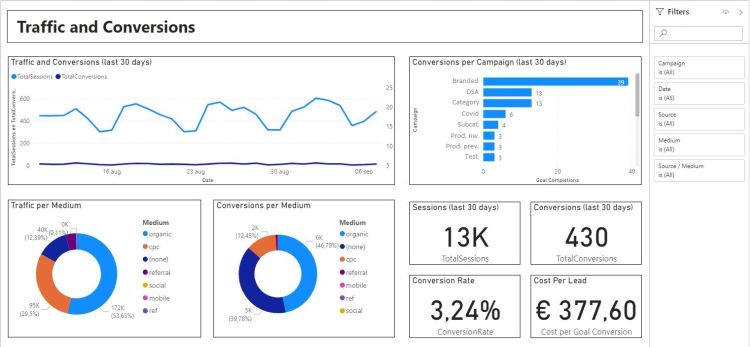We marketers and marketing managers want us and our work to be seen, especially within the company or organization for which we work. This visibility helps us, among other things, in obtaining resources and in our career. It is therefore important that we convince not only our direct executives of our results, but also the CEO of the company or organization for which we work. In this article I share a couple of useful tips with you, focussing on dashboarding.
Time and attention are scarce
First of all, an important point of attention: the time and attention of the C-suite, which includes not only the CEO but also the influential CFO, are scarce. They must therefore get your results presented right under their nose, orderly and easy to understand. Read further to learn how to do this.
Always there, at the right time
In order to continue to convince the C-suite you should not depend on a periodic – or perhaps even incidental – presentation or the casual chat at the coffee machine or the Christmas drink. No, as soon as they dive into the performance figures of the company or organization (and they do that more often than you think), your marketing results must be there.
Always there, in the right place
The C-suite does not use Google Analytics. Or Google Data Studio. And as much as you would like it, they are not going to do that either (because as said before, their time and attention are scarce). The results that they view and based on which they manage the company are in management dashboards and reports, so your marketing results also be there.
These management dashboards and reports are usually part of a business intelligence environment. If your CEO and CFO use Power BI, your marketing KPIs will shine in there. Ditto for Tableau, Qlik, Oracle, MicroStrategy, or any BI tool. Ensure that the main marketing KPIs are part of the management dashboards and reports that the C-suite regularly uses.
Focus on the right KPIs
The C-suite is not interested in reach, CPM, CPC, ROAS, conversion rates, average transaction values, bounce rates, etc. For them, the KPIs that matter are the ones that focus on sales, profit, margins (net, gross, operational), costs, return, cash position, growth and churn of customers, and perhaps also things like reputation and customer satisfaction.
What about my marketing KPIs? You will ask. Keep those to yourself and your colleagues, in your own reports and dashboards. But let them be part of the same business intelligence environment so that a curious CEO or CFO always has one-click access to your detailed information about, for example, the costs and profit contribution of a particular campaign.
Keep it simple
As mentioned, the C-suite should get your results presented right under their nose, orderly and easy to understand. The data visualisations of those results in the management dashboards and reports must therefore provide the correct information at a glance. Therefore, use cards, meters and KPI visuals rather than diagrams, graphs and tables. And here too, the curious CEO or CFO should always have one-click access to the underlying detailed information.
Always up to date
High-over KPIs in management dashboards and reports are often only refreshed monthly due to financial cycles, but operational KPIs in particular are viewed more often because they require short-term management. This means that your CEO will chek his management dashboards and reports much more often. The number fetishists among them will do so almost every day.
This is why it is important that your marketing results in those management dashboards and reports are always up to date. Make sure that they are automatically refreshed daily. That is not hard; most business intelligence tools can be linked to marketing tools such as Google Analytics, CRM and marketing automation systems, Google / Bing / Facebook Ads and other advertising platforms. Refreshes can often be scheduled automatically, even several times a day. Here you can read how this works with, for example, Google Analytics data in Power BI.
Finally
There is much to tell about management and marketing dashboarding and reporting. Maybe I’ll do that in future articles here. Who knows. For the time being, this article can go a long way in convincing your CEO with your marketing results. If you have any questions about this, ask them in the comments box at the bottom of this article.

